Helium (He) is the second lightest element in the universe and the second most abundant, and yet is incredibly rare here on earth. While the process of fusion in our sun produces an estimated 700 million tons of helium per second, our earth’s atmosphere has only a paltry 0.0005 percent helium, the rest having escaped into space over time.[1] It is its lightness that makes He an elusive “escape artist” – we cannot seem to hold onto it in the earth’s atmosphere – it just flies away, like… well, like a helium balloon. However, helium is not quite so elusive when it comes to the subsurface. Helium is formed through the alpha decay of uranium and thorium and can be trapped in the earth’s crust given the right geological conditions. Today, helium can be produced from some reservoirs with natural gases or in reservoirs containing mostly nitrogen.
Fact: Helium gets its name from the Greek, “Helios,” meaning sun.
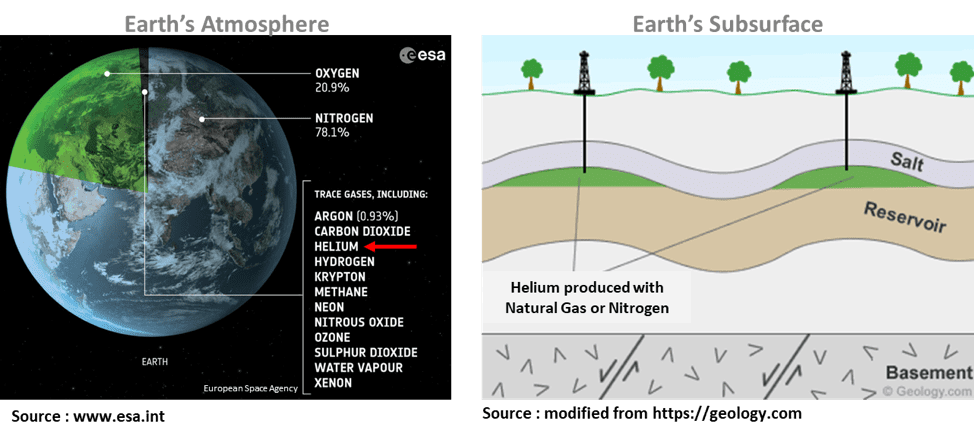 A Unique Element, and Its Growing Uses [1] [2]
A Unique Element, and Its Growing Uses [1] [2]
Mention helium to most people, and their first thought will be of the whimsical helium filled balloons we mentioned earlier, or the squeaky voice they get from inhaling the helium from those balloons. In truth, helium has far greater and irreplaceable applications.
Helium is a noble gas: It is colorless, odorless and inert with unique properties. It is the most stable of all the elements; it will not burn or react with other elements. Helium has the lowest boiling point of all elements – 4.2 degrees Kelvin (-268.8 degrees Celsius) – just four degrees above absolute zero. It is the only element that cannot be solidified by sufficient cooling at normal atmospheric pressure. Therefore, helium is highly sought after in countless industries across the globe.
 There are several critical applications where helium cannot be replaced with other gases, such as the use in magnetic resonance imaging (MRI) scanners, space exploration and some scientific research. Each MRI machine requires eight hundred to two thousand liters of helium to cool its superconducting magnets. The National Aeronautics and Space Administration (NASA) uses helium to purge rockets before fueling. In our current technology, helium is used in electronic devices for operational excellence. In automobiles, air bags are filled with helium due to its non-combustible and non-toxic properties. The low boiling point of helium makes it extremely useful for cryogenic applications. There are countless more applications as highlighted in Figures 1&2.
There are several critical applications where helium cannot be replaced with other gases, such as the use in magnetic resonance imaging (MRI) scanners, space exploration and some scientific research. Each MRI machine requires eight hundred to two thousand liters of helium to cool its superconducting magnets. The National Aeronautics and Space Administration (NASA) uses helium to purge rockets before fueling. In our current technology, helium is used in electronic devices for operational excellence. In automobiles, air bags are filled with helium due to its non-combustible and non-toxic properties. The low boiling point of helium makes it extremely useful for cryogenic applications. There are countless more applications as highlighted in Figures 1&2.
Fact: Conglomerates like Google, Facebook, Amazon and Netflix are heavy users of helium in their massive data centers.
![Figure 1: Growing uses of helium (graphic from avantihelium.com) [3]](https://oilwomanmagazine.com/wp-content/uploads/sites/2/2022/11/Helium3.png)
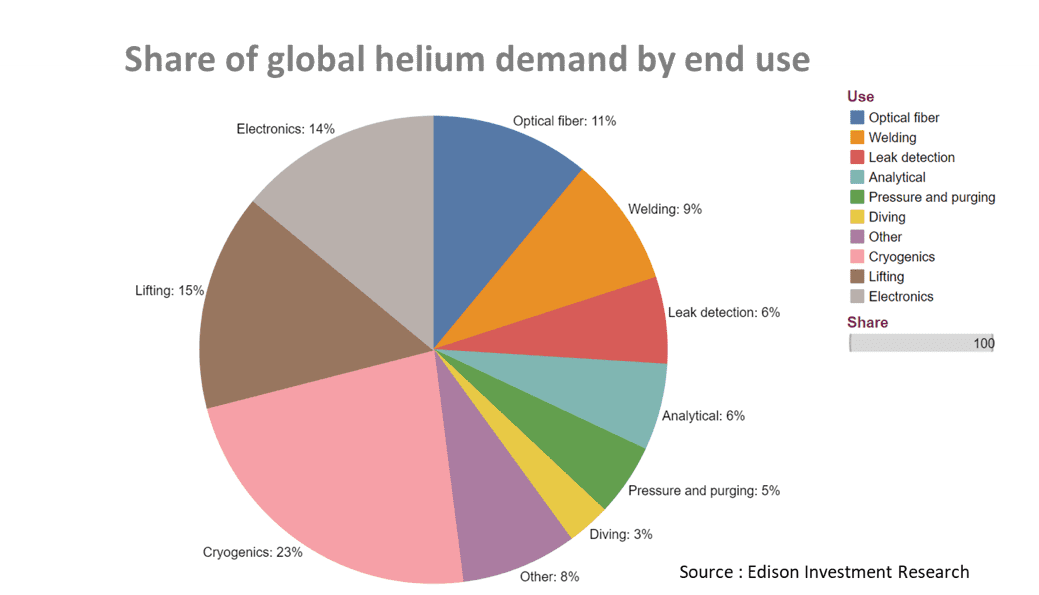
Due to its unique properties and the rapidly expanding uses for this element, the demand for helium is continuing to grow. The global market for this non-renewable resource is set to increase, even by a conservative estimate, at a compound annual growth rate (CAGR) of over 6.5 percent by 2025 (see Figure 3).
![Figure 3: Growing global market (chart from avantihelium.com) [3]](https://oilwomanmagazine.com/wp-content/uploads/sites/2/2022/11/Helium5.png)
The Global Helium Market [3] [4]
The world’s helium supply is currently located in just a handful of countries across the globe. For several decades, the United States dominated the market for helium production accounting for approximately forty percent of the supply. Prior to 2021, the U.S. National Helium Reserve in Amarillo, Texas, was the world’s single largest source of helium for the past seventy years. The Helium Stewardship Act expired in Sept 2021, and the U.S. Bureau of Land Management (BLM) has been auctioning off all remaining helium reserves, thus depleting its national reserves. The source of supply to the Reserve is a natural gas field that is decades old and in decline.
In the last decade, Algeria, Qatar, Russia, Poland and Australia have joined the helium supply market. Helium production from these regions is typically from extremely low concentrations and is associated with conventional natural gas production which is only made economic through large scale cryogenic liquified natural gas (LNG) plants. The hunt for helium as a primary target has also started to gain momentum in western Canada (see Figures 3, 4 & 5).
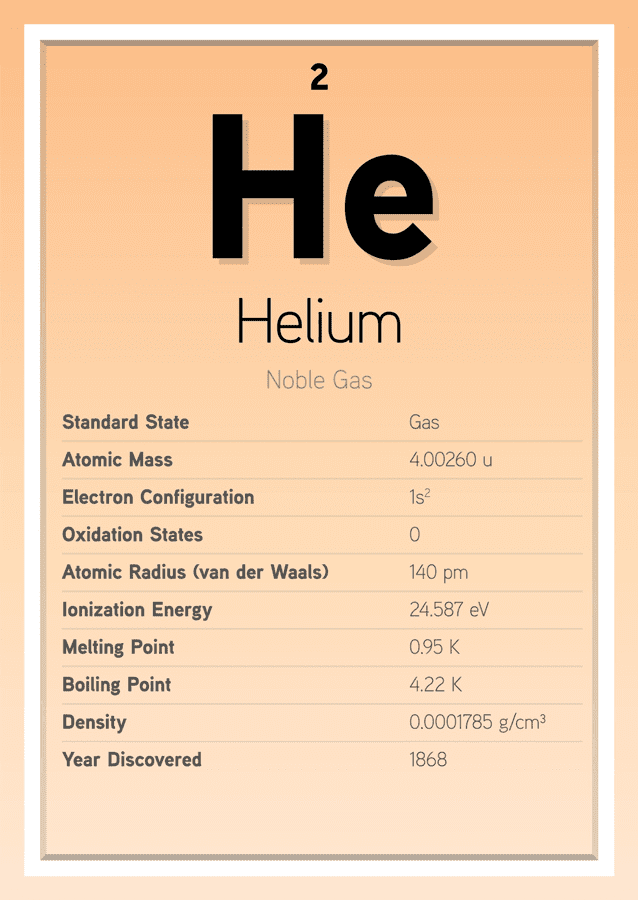
Important market changes, including the shutdown of the U.S. Helium Reserve and the emergence of high geopolitical risk to the producers in eastern parts of our globe, have driven an explosion of interest in exploring for and developing helium reserves in North America.
In the United States, several of the helium rich fields were discovered by companies searching for hydrocarbons. The main helium fields are in Kansas, Texas, Oklahoma, Wyoming, eastern Colorado and in a region called the Four Corners, with more recent exploration activities in Montana.
In Canada, several companies have emerged in the last decade focusing on helium produced primarily with nitrogen. The geographic locations of the helium fields in Canada are rich with nitrogen with low concentrations of methane and carbon dioxide. Considered a “green” helium, the development in these fields will have a smaller environmental footprint and a lower or net zero emissions. The current hot spots for green helium exploration and production in Canada are in the southern regions of Alberta and Saskatchewan. (see Figure 5).
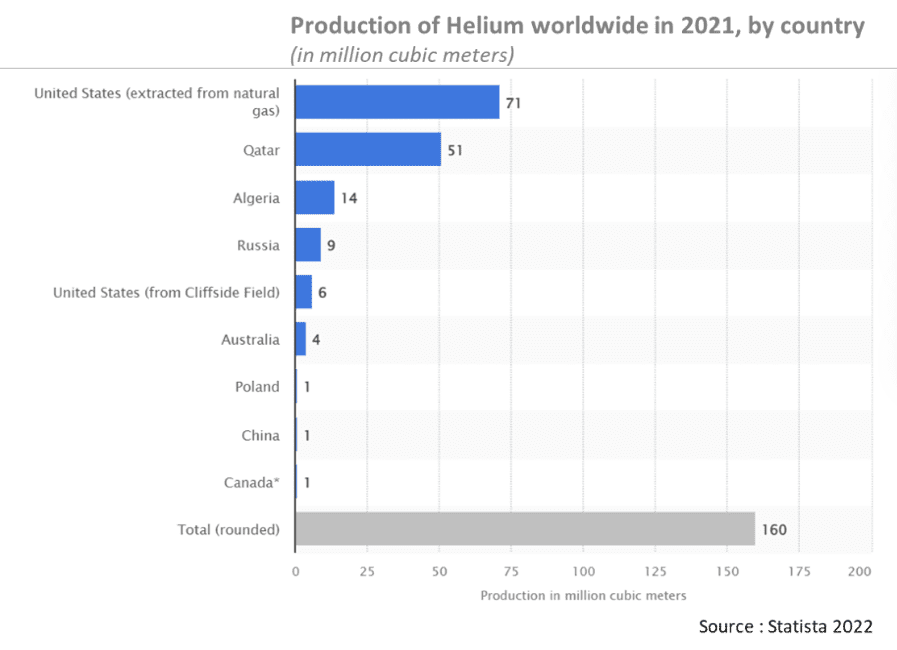
![Figure 5: North America helium fields (modified from www.usgs.gov) [4]](https://oilwomanmagazine.com/wp-content/uploads/sites/2/2022/11/Helium7.png)
A conundrum in the helium market is the pricing since there is not a standard price like the Western Texas Intermediate (WTI) for oil or Henry Hub (HH) for gas. The market for helium is primarily governed by private contracts and prices are kept confidential. The United States Geological Survey (USGS) estimates Grade A helium (99 percent helium) has traded for ~$200-250 USD per thousand cubic feet (mcf) since 2019. A more recent estimate is between $300/mcf to $800/mcf in 2022, with anecdotal evidence of prices significantly higher still.
![Figure 6: Historical helium pricing (chart from avantihelium.com) [3]](https://oilwomanmagazine.com/wp-content/uploads/sites/2/2022/11/Helium8.png)
Exploring for and Producing Helium
There are two main types of commercial helium deposits: Helium produced with hydrocarbon and helium produced primarily with nitrogen.
The exploration methodology and the drilling for helium is identical to drilling for conventional natural gas. Exploring for helium is as technically challenging and requires significant knowledge related to helium generation, migration, exsolution, accumulation and trapping (see Figure 7). [5]
- Helium generation on earth is associated with the radioactive decay of uranium and thorium. High uranium and thorium content are primarily sourced from deep basement granitic rock.
- Next is the primary migration of the helium from the source rock, there must be adequate fractures and faults in the granitic source rock to allow the helium to escape. Radiogenic helium is also consistently associated with nitrogen that is likely carrying the helium out of the source rock.
- Once the helium has migrated out of the source, a secondary migration is required in a fluid phase, a conduit to move the helium up the overlying sedimentary rock
- Helium then gets exsolved from the groundwater to any pre-existing gas cap in a reservoir rock.
- An overlying caprock that is tight enough is required to trap the helium in the reservoir for commercial development.
![Figure 7: Helium generation and trapping model (graphic modified from avantihelium.com) [3]](https://oilwomanmagazine.com/wp-content/uploads/sites/2/2022/11/Helium9.png)
Fact: Helium was the first element not to be discovered on earth. In 1868, during a total eclipse, helium was discovered on the sun using a spectroscope. Terrestrial helium was not discovered until 1895.
Like natural gas production and processing, the produced helium is gathered in a centralized processing facility where it is purified and sold as gas or liquid. The gaseous purification process uses an extremely reliable pressure swing adsorption (PSA) and membrane technology. A cryogenic distillation method is often used for liquefaction. Once the helium has been separated from the natural gas or nitrogen, it undergoes further refining to bring it to 99.99+ percent purity for commercial use.
![Figure 8: Helium separation and purification (graphic from avantihelium.com) [3]](https://oilwomanmagazine.com/wp-content/uploads/sites/2/2022/11/Helium10.png)
From Whimsical Balloons to Space Rockets
Whether helium is used to inflate party balloons or in the medical field or to help lift off a space rocket, the demand for helium will just continue to grow, and it is a commodity to keep a close eye on in the coming decades.
About Avanti Helium Corporation
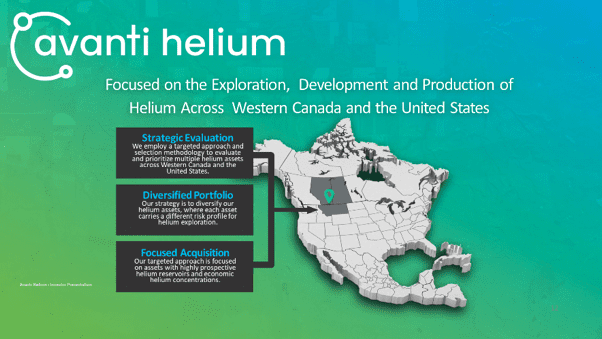 Canadian junior explorer Avanti Helium Corp., a publicly traded company, is focused on exploration, development and production of nitrogen rich helium across western Canada and the United States. It is in a prime position to benefit from the emerging helium rush. It has a technical team with decades of experience working in the oil and gas sector. Avanti acquired the helium rights on land in some of the best helium prospecting areas in Alberta, Montana and Saskatchewan.
Canadian junior explorer Avanti Helium Corp., a publicly traded company, is focused on exploration, development and production of nitrogen rich helium across western Canada and the United States. It is in a prime position to benefit from the emerging helium rush. It has a technical team with decades of experience working in the oil and gas sector. Avanti acquired the helium rights on land in some of the best helium prospecting areas in Alberta, Montana and Saskatchewan.
To date, Avanti has drilled a successful helium discovery well in northwestern Montana in an area called Greater Knappen that has a sizable helium resource. The company has initiated a preliminary front end engineering and design (Pre-FEED) to bring the discovery well on production as quickly as possible.
Avanti continues to acquire additional top tier helium prospects to diversify its helium portfolio and is poised to become an industry leader in helium production. www.avantihelium.com.
Sources
[1] www.britannica.com : Information on helium properties.
[2] geology.com/articles/helium : Articles on helium properties and uses.
[3] avantihelium.com : Graphics, charts and helium exploration in Canada and Montana sourced from Avanti Investor Presentation.
[4] www.usgs.gov : Information on helium statistics and fields in North America, Helium Stewardship Act and historical helium pricing.
[5] physicsworld.com : On the Hunt for Helium – Helium Generation and Exploration.
Born in Malaysia, where she lived most of her childhood years, Genga Nadaraju decided to venture to the U.S. for her postsecondary education. She obtained her geology degree at The College of Wooster, Ohio, and did her master’s degree at The University of British Columbia, Canada. Her career took her to Calgary, Alberta, where she has over 25 years of diverse professional experience in the oil and gas industry that includes business development, asset exploitation, strategic planning, and investor relations. Nadaraju is currently the VP Subsurface at Avanti Helium Corporation, a start-up helium company based in Calgary. She enjoys the outdoors, hiking in the Canadian Rockies, loves travelling, enjoys preparing and having meals with family and friends or just reading a good book. Currently, she is reading Knights in Retrograde from the Dynamicist Trilogy by Lee Hunt.
Oil and gas operations are commonly found in remote locations far from company headquarters. Now, it's possible to monitor pump operations, collate and analyze seismic data, and track employees around the world from almost anywhere. Whether employees are in the office or in the field, the internet and related applications enable a greater multidirectional flow of information – and control – than ever before.



